Abstract
Significant levels of antibodies indicative of a variety of zoonotic infections were demonstrated in sera collected from 64 U.S. military scout and tracker dogs after service in the Republic of Vietnam (RVN). Scrub typhus antibodies were found in 45% of the specimens, melioidosis in 19%, group B arbovirus in 49%, and leptospirosis in 62%. Only 38% of the seropositive reactions for leptospirosis could be related to overseas infections. Tests were conducted on paired sera obtained from 32 of the dogs before service in RVN. Significant increases in titer were demonstrated with scrub typhus, melioidosis, leptospirosis, plague, group B arbovirus, and Rickettsia canada antigens. After 2 to 6 months of service in RVN, 8 of 19 dogs developed antibody titers to at least one of four zoonotic diseases. Only 3 of 45 dogs with 7 or more months of service failed to develop antibodies to one or more of the agents. The serological findings pose questions on the potential epidemiological importance and veterinary significance of scrub typhus, group B arbovirus, leptospirosis, and melioidosis infections in dogs.
Full text
PDF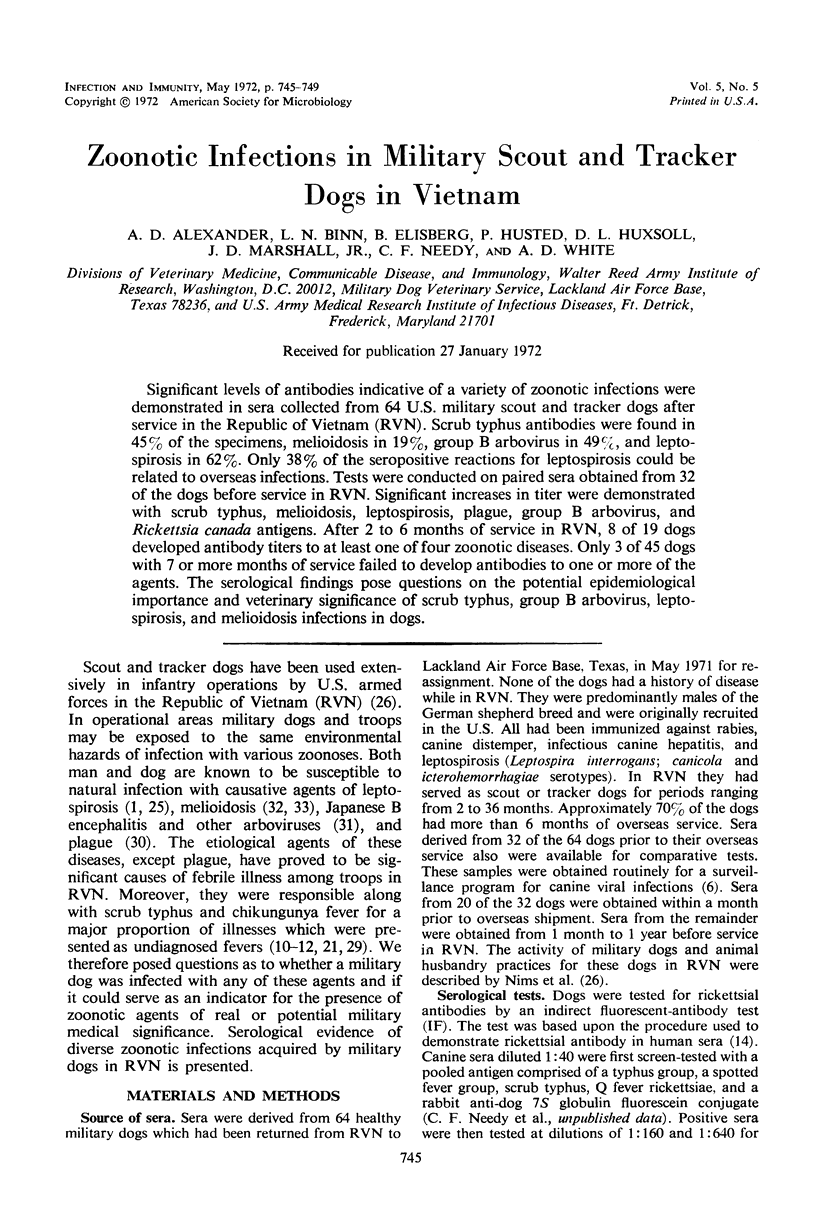
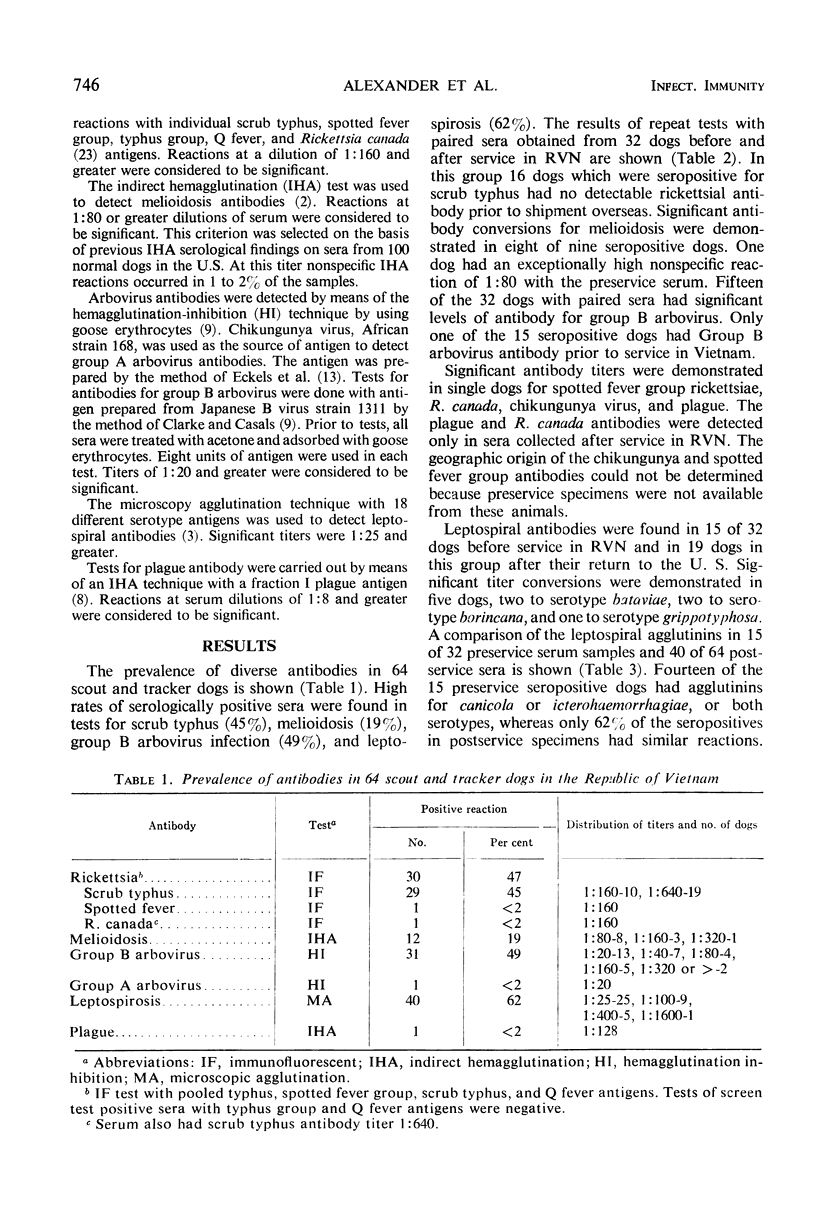
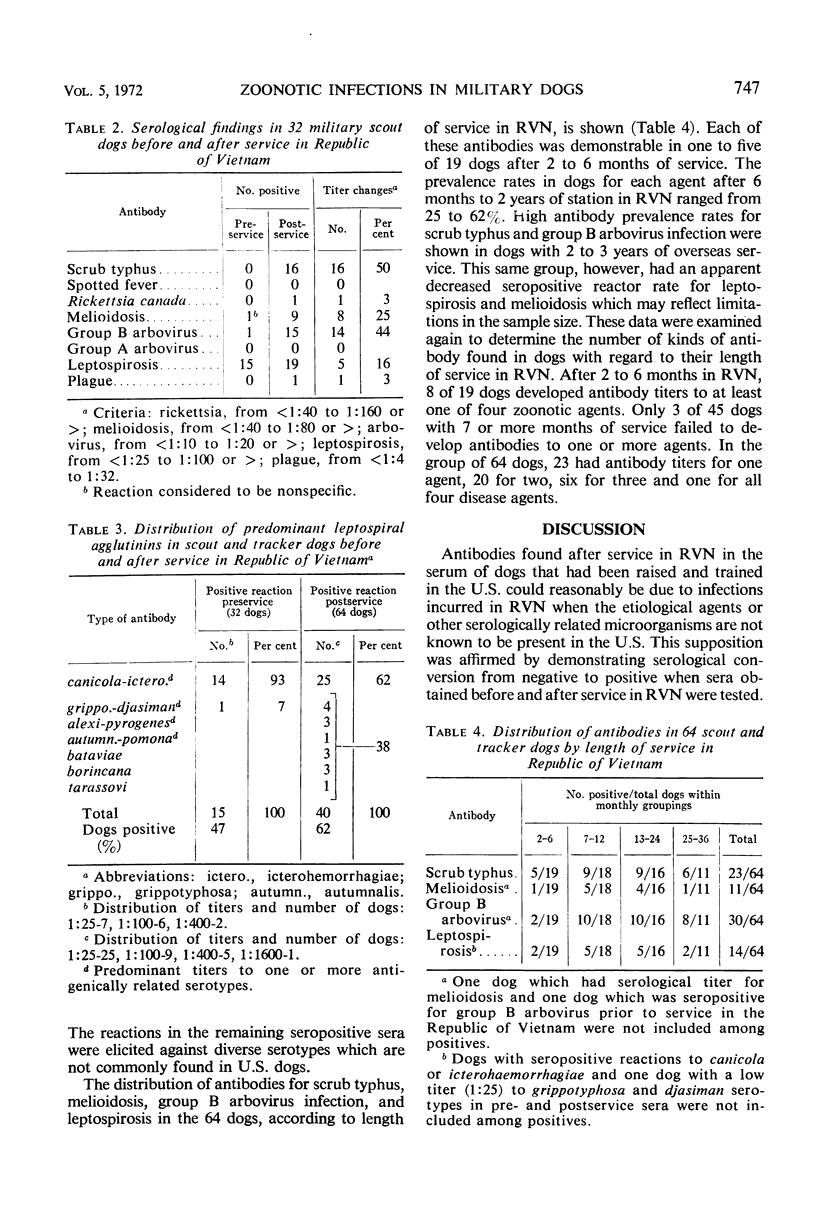
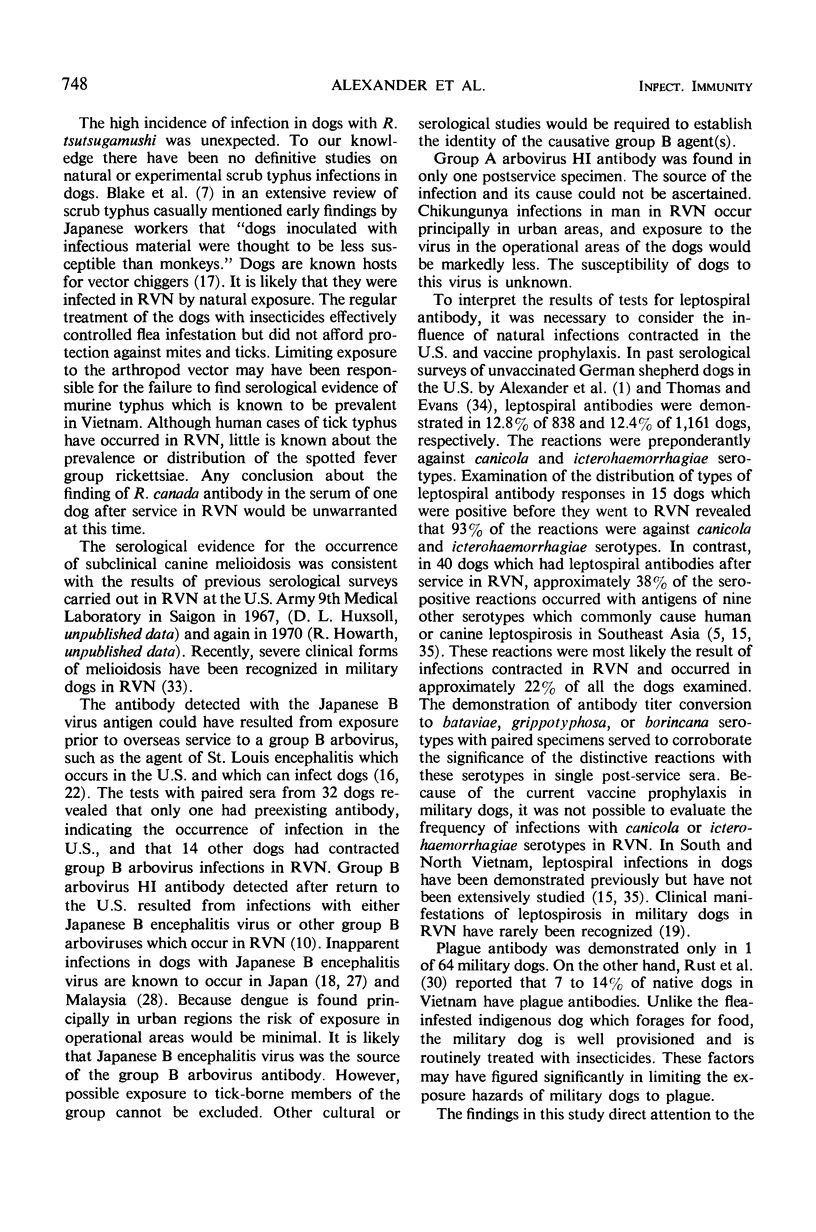
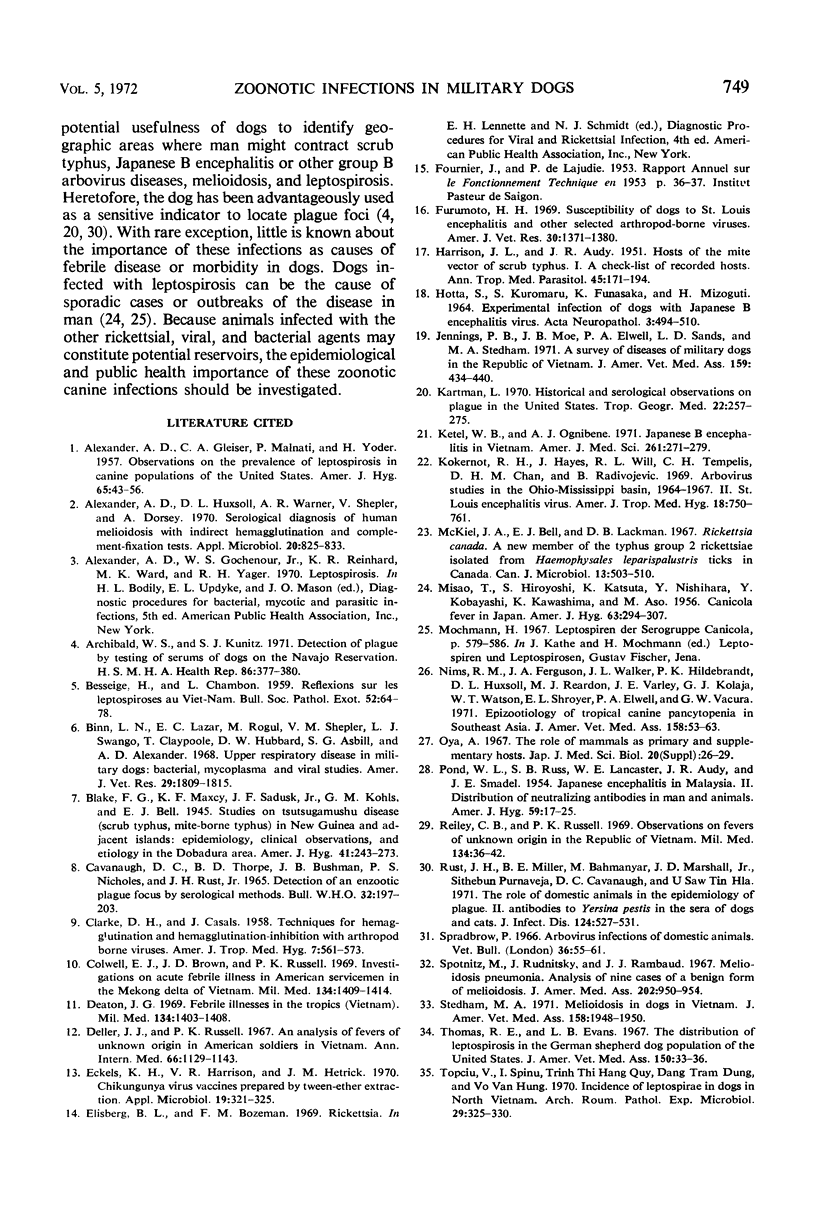
Selected References
These references are in PubMed. This may not be the complete list of references from this article.
- ALEXANDER A. D., GLEISER C. A., MALNATI P., YODER H. Observations on the prevalence of leptospirosis in canine populations of the United States. Am J Hyg. 1957 Jan;65(1):43–56. doi: 10.1093/oxfordjournals.aje.a119855. [DOI] [PubMed] [Google Scholar]
- Alexander A. D., Huxsoll D. L., Warner A. R., Jr, Shepler V., Dorsey A. Serological diagnosis of human melioidosis with indirect hemagglutination and complement fixation tests. Appl Microbiol. 1970 Nov;20(5):825–833. doi: 10.1128/am.20.5.825-833.1970. [DOI] [PMC free article] [PubMed] [Google Scholar]
- Archibald W. S., Kunitz S. J. Detection of plague by testing serums of dogs on the Navajo Reservation. HSMHA Health Rep. 1971 Apr;86(4):377–380. [PMC free article] [PubMed] [Google Scholar]
- BESSEIGE H., CHAMBON L. Réflexions sur les leptospiroses au Viet-Nam. Bull Soc Pathol Exot Filiales. 1959 Jan-Feb;52(1):64–78. [PubMed] [Google Scholar]
- Binn L. N., Lazar E. C., Rogul M., Shepler V. M., Swango L. J., Claypoole T., Hubbard D. W., Asbill S. G., Alexander A. D. Upper respiratory disease in military dogs: bacterial, mycoplasma, and viral studies. Am J Vet Res. 1968 Sep;29(9):1809–1815. [PubMed] [Google Scholar]
- CAVANAUGH D. C., THORPE B. D., BUSHMAN J. B., NICHOLES P. S., RUST J. H., Jr DETECTION OF AN ENZOOTIC PLAGUE FOCUS BY SEROLOGICAL METHODS. Bull World Health Organ. 1965;32:197–203. [PMC free article] [PubMed] [Google Scholar]
- CLARKE D. H., CASALS J. Techniques for hemagglutination and hemagglutination-inhibition with arthropod-borne viruses. Am J Trop Med Hyg. 1958 Sep;7(5):561–573. doi: 10.4269/ajtmh.1958.7.561. [DOI] [PubMed] [Google Scholar]
- Colwell E. J., Brown J. D., Russell P. K., Boone S. C., Legters L. J. Catino D: Investigations on acute febrile illness in American servicemen in the Mekong Delta of Vietnam. Mil Med. 1969 Nov;134(12):1409–1414. [PubMed] [Google Scholar]
- Deaton J. G. Febrile illnesses in the tropics (Vietnam). Mil Med. 1969 Nov;134(12):1403–1408. [PubMed] [Google Scholar]
- Deller J. J., Jr, Russell P. K. An analysis of fevers of unknown origin in American soldiers in Vietnam. Ann Intern Med. 1967 Jun;66(6):1129–1143. doi: 10.7326/0003-4819-66-6-1129. [DOI] [PubMed] [Google Scholar]
- Eckels K. H., Harrison V. R., Hetrick F. M. Chikungunya virus vaccine prepared by Tween-ether extraction. Appl Microbiol. 1970 Feb;19(2):321–325. doi: 10.1128/am.19.2.321-325.1970. [DOI] [PMC free article] [PubMed] [Google Scholar]
- Furumoto H. H. Susceptibility of dogs to St. Louis encephalitis and other selected arthropod-borne viruses. Am J Vet Res. 1969 Aug;30(8):1371–1380. [PubMed] [Google Scholar]
- HARRISON J. L., AUDY J. R. Hosts of the mite vector of scrub typhus. I. A check list of the recorded hosts. Ann Trop Med Parasitol. 1951 Dec;45(3-4):171–185. doi: 10.1080/00034983.1951.11685486. [DOI] [PubMed] [Google Scholar]
- HOTTA S., KUROMARU S., FUNASAKA K., MIZOGUTI H. EXPERIMENTAL INFECTION OF DOGS WITH JAPANESE B ENCEPHALITIS VIRUS. Acta Neuropathol. 1964 May 5;3:494–510. doi: 10.1007/BF00688458. [DOI] [PubMed] [Google Scholar]
- Jennings P. B., Moe J. B., Elwell P. A., Sands L. D., Stedham M. A. A survey of diseases of military dogs in the Republic of Vietnam. J Am Vet Med Assoc. 1971 Aug 15;159(4):434–440. [PubMed] [Google Scholar]
- Kartman L. Historical and oecological observations on plague in the United States. Trop Geogr Med. 1970 Sep;22(3):257–275. [PubMed] [Google Scholar]
- Ketel W. B., Ognibene A. J. Japanese B encephalitis in Vietnam. Am J Med Sci. 1971 May;261(5):271–279. doi: 10.1097/00000441-197105000-00006. [DOI] [PubMed] [Google Scholar]
- Kokernot R. H., Hayes J., Will R. L., Tempelis C. H., Chan D. H., Radivojević B. Arbovirus studies in the Ohio-Mississippi Basin, 1964-1967. II. St. Louis encephalitis virus. Am J Trop Med Hyg. 1969 Sep;18(5):750–761. doi: 10.4269/ajtmh.1969.18.750. [DOI] [PubMed] [Google Scholar]
- MISAO T., HIROYOSHI S., KATSUTA K., NISHIHARA Y., KOBAYASHI Y., KUWASHIMA K., ASO M. Canicola fever in Japan. Am J Hyg. 1956 May;63(3):294–307. doi: 10.1093/oxfordjournals.aje.a119813. [DOI] [PubMed] [Google Scholar]
- McKiel J. A., Bell E. J., Lackman D. B. Rickettsia canada: a new member of the typhus group of rickettsiae isolated from Haemaphysalis leporispalustris ticks in Canada. Can J Microbiol. 1967 May;13(5):503–510. doi: 10.1139/m67-065. [DOI] [PubMed] [Google Scholar]
- Nims R. M., Ferguson J. A., Walker J. L., Hildebrandt P. K., Huxsoll D. L., Reardon M. J., Varley J. E., Kolaja G. J., Watson W. T., Shroyer E. L. Epizootiology of tropical canine pancytopenia in Southeast Asia. J Am Vet Med Assoc. 1971 Jan 1;158(1):53–63. [PubMed] [Google Scholar]
- Oya A. The role of mammals as primary and supplementary hosts. Jpn J Med Sci Biol. 1967 Dec;20 (Suppl):26–30. [PubMed] [Google Scholar]
- POND W. L., RUSS S. B., LANCASTER W. E., AUDY J. R., SMADEL J. E. Japanese encephalitis in Malaya. II. Distribution of neutralizing antibodies in man and animals. Am J Hyg. 1954 Jan;59(1):17–25. [PubMed] [Google Scholar]
- Reiley C. G., Russell P. K. Observations on fevers of unknown origin in the Rephblic of Vietnam. Mil Med. 1969 Jan;134(1):36–42. [PubMed] [Google Scholar]
- Rust J. H., Jr, Miller B. E., Bahmanyar M., Marshall J. D., Jr, Purnaveja S., Cavanaugh D. C., Hla U. S. The role of domestic animals in the epidemiology of plague. II. Antibody to Yersinia pestis in sera of dogs and cats. J Infect Dis. 1971 Nov;124(5):527–531. doi: 10.1093/infdis/124.5.527. [DOI] [PubMed] [Google Scholar]
- Spotnitz M., Rudnitzky J., Rambaud J. J. Melioidosis pneumonitis. Analysis of nine cases of a benign form of melioidosis. JAMA. 1967 Dec 4;202(10):950–954. doi: 10.1001/jama.202.10.950. [DOI] [PubMed] [Google Scholar]
- Stedham M. A. Melioidosis in dogs in Vietnam. J Am Vet Med Assoc. 1971 Jun 1;158(11):1948–1950. [PubMed] [Google Scholar]
- Topciu V., Spînu I., Hang Quy T. T., Dung D. T., Hung V. V. Incidence of leptospirae in dogs in North Vietnam. Arch Roum Pathol Exp Microbiol. 1970 Mar-Jun;29(1):325–330. [PubMed] [Google Scholar]


